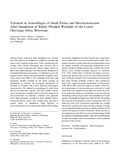| dc.contributor.author | Siziba, Nqobizitha | |
| dc.contributor.author | Chimbari, Moses J. | |
| dc.contributor.author | Masundire, Hillary | |
| dc.contributor.author | Mosepele, Ketlhatlogile | |
| dc.contributor.author | Ramberg, Lars | |
| dc.date.accessioned | 2015-02-27T06:09:05Z | |
| dc.date.available | 2015-02-27T06:09:05Z | |
| dc.date.issued | 2013-09-30 | |
| dc.identifier.citation | Siziba, NQobizitha. et al ( 2013) Variation in assemblages of small Fishes and microcrustaceans after inundation of rarely flooded wetlands of the lower Okavango Delta, Botswana, Environmental Management, Vol. 52, Issue 6., pp. 1386-1399 | en_US |
| dc.identifier.issn | 0364-152X ( Print) | |
| dc.identifier.issn | 1432-1009 (Online) | |
| dc.identifier.uri | http://hdl.handle.net/10311/1338 | |
| dc.description.abstract | Water extraction from floodplain river systems may alter patterns of inundation of adjacent wetlands and lead to loss of aquatic biodiversity. Water reaching the Okavango Delta (Delta), Botswana, may decrease due to excessive water extraction and climate change. However, due to poor understanding of the link between inundation of wetlands and biological responses, it is difficult to assess the impacts of these future water developments on aquatic biota. Large floods from 2009 to 2011 inundated both rarely and frequently flooded wetlands in the Delta, creating an opportunity to examine the ecological significance of flooding of wetlands with widely differing hydrological characteristics. We studied the assemblages of small fishes and microcrustaceans, together with their trophic relationships, in temporary wetlands of the lower Delta. Densities of microcrustaceans in temporary wetlands were generally lower than previously recorded in these habitats. Microcrustacean density varied with wetland types and hydrological phase of inundation. High densities of microcrustaceans were recorded in the 2009 to 2010 flooding season after inundation of rarely flooded sites. Large numbers of small fishes were observed during this study. Community structure of small fishes differed significantly across
the studied wetlands, with poeciliids predominant in frequently flooded wetlands and juvenile cichlids most abundant in rarely flooded wetlands (analysis of similarity, P\0.05). Small fishes of\20 mm fed largely on microcrustaceans and may have led to low microcrustacean densities within the wetlands. This result matched our prediction that rarely flooded wetlands would be more productive; hence, they supported greater populations of microcrustaceans and cichlids, which are aggressive feeders. However,
the predominance of microcrustaceans in the guts of small fishes (\20 mm) suggests that predation by fishes may also be an important regulatory mechanism of microcrustacean assemblages during large floods when inundated terrestrial patches of wetlands are highly accessible by fish. We predict that a decline in the amount of water reaching the Delta will negatively affect fish recruitment, particularly the cichlids that heavily exploited the rarely flooded wetlands. Cichlids are an important human food source, and their decline in fish catches will negatively affect livelihoods. Hence, priority in the management of the Delta’s ecological functioning should be centred on minimising natural water-flow modifications because any changes may be detrimental to fish-recruitmentprocesses of the system. | en_US |
| dc.description.sponsorship | This study was funded by Carnegie–RISE through the Sub-Saharan Africa Water Resources Network | en_US |
| dc.language.iso | en | en_US |
| dc.publisher | Springer, www.springer.com | en_US |
| dc.subject | Microcrustaceans | en_US |
| dc.subject | Flooding frequency | en_US |
| dc.subject | Juvenile fish | en_US |
| dc.subject | Fish predation | en_US |
| dc.title | Variation in assemblages of small fishes and microcrustaceans after inundation of rarely flooded wetlands of the lower Okavango Delta, Botswana | en_US |
| dc.type | Published Article | en_US |
| dc.link | http://www.ncbi.nlm.nih.gov/pubmed/24196137 | en_US |

